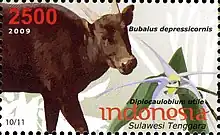| Dendrobium utile | |
|---|---|
 | |
| Dendrobium utile and a lowland anoa (Bubalus depressicornis) on a 2009 stamp of Indonesia | |
| Scientific classification | |
| Kingdom: | Plantae |
| Clade: | Tracheophytes |
| Clade: | Angiosperms |
| Clade: | Monocots |
| Order: | Asparagales |
| Family: | Orchidaceae |
| Subfamily: | Epidendroideae |
| Genus: | Dendrobium |
| Species: | D. utile |
| Binomial name | |
| Dendrobium utile | |
| Synonyms | |
|
Diplocaulobium utile (J.J.Sm.) Kraenzl. | |
Dendrobium utile is a species of orchid native to Sulawesi and Papua, occurring in forests at altitudes of up to 150 m.[1] It is the official flower of Sulawesi Tenggara.[2] Locally this orchid is also called anomi, anemi or alemi, or anggrek serat (fiber orchid) from its fiber-rich root.
Description
Dendrobium utile is an epiphyte.[1] It is distinguished from similar orchids by the root shaped like a bird nest with green-yellowish colors. The flowers grow in the leaf axils. The petals are yellow, with a narrow shape. The plants make attractive decorations, but are short-lived. The roots are used to make expensive handcrafts because of its soft texture and shiny and golden color.
References
- 1 2 "Dendrobium utile". Useful tropical plants.
- ↑ "Dendrobium". Do-apps.com. Archived from the original on 2017-01-09. Retrieved 2016-09-15.
External links
This article is issued from Wikipedia. The text is licensed under Creative Commons - Attribution - Sharealike. Additional terms may apply for the media files.